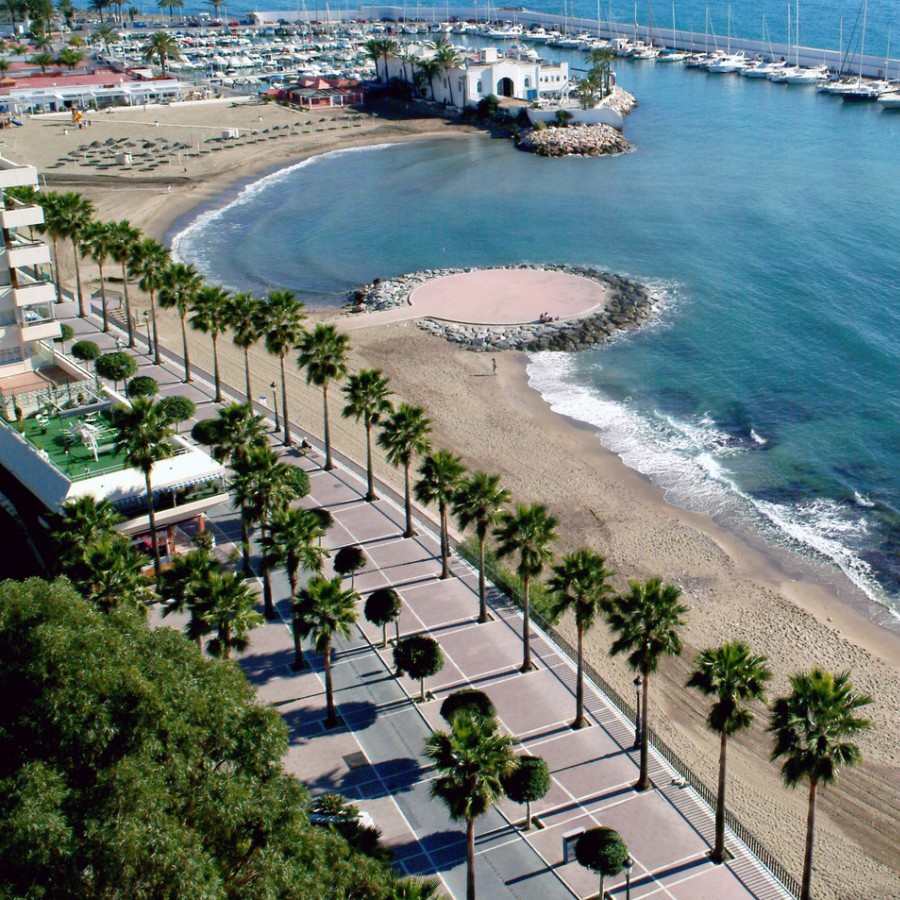La Fontanilla, una fuente de agua dulce en la misma playa
Esta playa recibe su nombre del manantial que vierte su agua en la misma orilla, a la altura de este cartel. Una fuente de agua dulce donde muchos marbellíes saciaron su sed (no es recomendable beberla hoy porque su agua no está tratada). En una crónica de la provincia de Málaga de José Bisso en 1869 se recoge una curiosa referencia a esta fuente: «Se cuentan dentro de Marbella nueve fuentes públicas y algunas otras en varias casas particulares. El agua es bastante alcalina y viene por arcaduz del sitio llamado Puerto Rico a media legua de la ciudad. Brota, sin embargo, otra fuente llamada la Fontanilla casi a la orilla del mar. Nacen esas aguas del foramen de una gran laja o piedra que las olas en sus continuos movimientos con mucha frecuencia cubren y no obstante su venero es dulce, delicado y de agradable frescura».
Estamos en una ruta por la biodiversidad urbana y conviene recordar que pese al carácter urbano de estas playas, en el siglo pasado se le denominaba a esta playa como Barronales de la Fontanilla. El barronal es como la gente de Marbella denominaban a las dunas, un paisaje único y característico de Marbella que solo los más mayores pueden recordar y que la fotografía de la izquierda nos testimonia. Afortunadamente existe una mayor conciencia medioambiental y cada vez hay más sistemas dunares protegidos en Marbella.
Luis de Góngora cita a Marbella y sus playas, en tiempo de piratas, en su poesía llamada “Amarrado al duro banco”
| Amarrado al duro banco
de una galera turquesca, ambas manos en el remo y ambos ojos en la tierra, un forzado de Dragut en la playa de Marbella se quejaba al ronco son del remo y de la cadena: «¡Oh sagrado mar de España, famosa playa serena, teatro donde se han hecho cien mil navales tragedias!, pues eres tú el mismo mar que con tus crecientes besas las murallas de mi patria, coronadas y soberbias, tráeme nuevas de mi esposa, y dime si han sido ciertas las lágrimas y suspiros que me dice por sus letras; |
porque si es verdad que llora mi cautiverio en tu arena, bien puedes al mar del Sur vencer en lucientes perlas. Dame ya, sagrado mar, a mis demandas respuesta, que bien puedes, si es verdad que las aguas tienen lengua, pero, pues no me respondes, sin duda alguna que es muerta, aunque no lo debe ser, pues que vivo yo en su ausencia. ¡Pues he vivido diez años sin libertad y sin ella siempre al remo condenado, a nadie matarán penas!» En esto se descubrieron de la Religión seis velas, y el cómitre mandó usar al forzado de su fuerza. |
The Fontanilla, a source os sweet water at the same beach
This beach receives its name of the spring that pours its water in the same shore, at the height of this poster. A source of fresh water where many marbellies have quenched their thirst (is not advisable to drink it nowadays since the water is not potable). In one of the newspapers of the Province of Malaga’s José Bisso in 1869, there is a curious reference to this water spring: «We can count in nine public water springs in Marbella, and some in several private homes. The water is quite transparent and flows through the pipelines of a homestead called Puerto Rico around one and a half mile away from the city. Nonetheless, there is another water spring called la Fontanilla almost at the waterside. The water springs out of a large slab or rocks which is constantly covered by the movement of the waves and the taste is sweet, delicate and pleasantly fresh».
We are on the way to the urban biodiversity urban and it is worth remembering that regardless of the urban nature of these beaches, in the last century, this beach was called Barronales de la Fontanilla. The barronal is what the inhabitants of Marbella called the dunes, a unique landscape and very representative of Marbella which can be recalled only by the elderly members of the community and this is depicted in the picture at the left. Fortunately, there is more environmental awareness and increasingly there are more dunes being protected in Marbella.
Luis de Góngora refers to Marbella and its beaches in that ancient time in which there were pirates and it can be read in his poem called “Anchored to the hard bench”
| Anchored to the hard bench of a Turkish galley, with both hands on the oar and both eyes on the land, a Spanish slave of Dragut off Marbella’s beach complains in time to the harsh rhythm of the oars and the chains: «Oh sacred sea of Spain! Oh serene and lovely shore! how many marine tragedies have played out here before! Since you are the same sea that kisses with its tides the walls of my native town with their ramparts and their towers, bring me tidings of my wife and tell me she’s not lying when she tells me in her letters of her tears and her sighing; |
if it’s true that on your sands for my bondage she sheds tears, then you can boast your beaches surpass the South Sea in pearls. Answer me, sea, I pray you, that’s something you can do, since water has a tongue, if what they say is true. But since you don’t reply it must mean she is dead, although it’s hardly possible that without her I still live. If without her and liberty, for ten years I’ve lived on, always chained to this oar, then grief never killed anyone!» But just then on the horizon six Christian sails were sighted, and the overseer ordered the slave to put his back into it. |

























